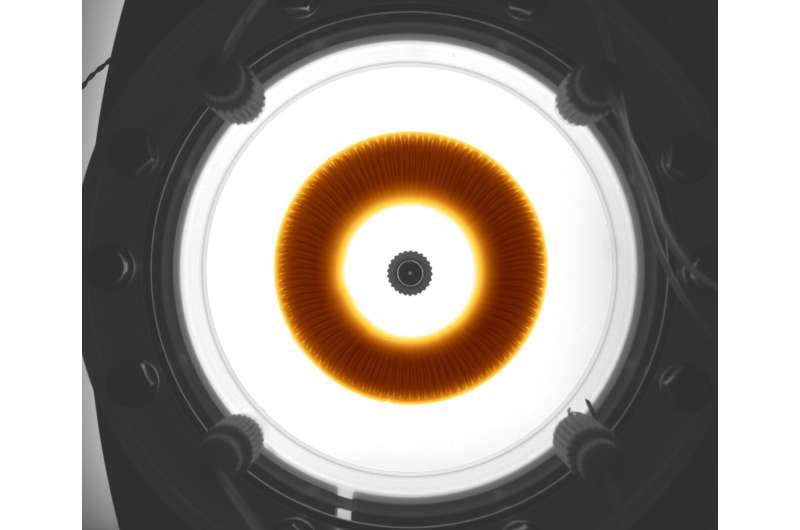Credit: K. Schwarzenberger & Y. Stergiou
What resembles a donut or the iris of an eye is actually a liquid cell illuminated from below.
Part of the Chemo-Hydrodynamic Patterns and Instabilities (CHYPI) experiment that recently flew on the 73rd ESA parabolic flight campaign, this cell has a lot to offer the chemical solutions industry.
Researchers behind CHYPI are seeking to validate a theoretical model, developed by Anne De Wit and her team at the Université Libre de Bruxelles, to control the formation of new chemical products.
To do this, they needed to understand the flow reactions of chemical liquids in gravity and microgravity conditions, so they took to the skies for an extraordinary parabolic flight campaign that was adjusted to COVID-19 safety measures.
The science team from Helmholtz-Zentrum Dresden-Rossendorf and TU Dresden mixed two reactant solutions in a liquid cell, creating a red-brown ferric thiocyanate solution. They found, that under gravity, the new product exhibits the patterned stripes imaged above, due to the flow of liquid. When gravity was 'switched off' for roughly 20 seconds as the Air Zero G airplane flew the curve of its parabola, the stripes were not present.
"We now understand better how the patterns in the product zone form: The dark stripes appear and disappear by switching on and off gravity during the parabolas," explains principal investigator Karin Schwarzenberger.
Improving the manufacturing of reactant solutions is of interest to the chemical solutions industry, which collaborates with this investigation. Soil remediation efforts would benefit from solutions that enable contaminated soil to be sealed off from surrounding ground water, for instance.
ESA's parabolic flight campaign was the first step for the project, allowing researchers to validate their experiment set up ahead of a longer duration study on the TEXUS-57 sounding rocket in April 2021.
Overall, the parabolic flight campaign was a success for all involved, despite the adjustments required to enable it to take place, such as changing location from France to Germany. Participants needed to show a negative COVID-19 PCR prior to coming to Germany, and once there had to take their temperatures regularly, observe strict social distancing in the large preparation hangar, and wear a mask at all times. This year's campaign also featured a limited number of experimenters on the aircraft and adaptations to the aircraft seating arrangement.
Provided by European Space Agency























